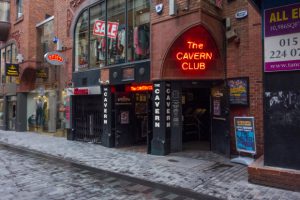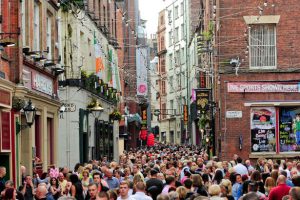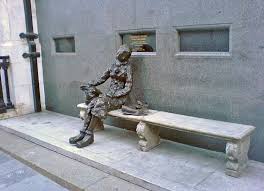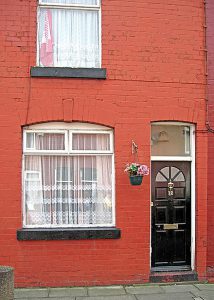As Liverpool has so much to see and do, we felt it best to give the Beatles their very own page.
You can book lots of different tours, but if you have transport it is easy to do it yourself. It can be done by public transport but would take a long time waiting around for buses etc.
The sights worth seeing.
The Cavern Club 10 Mathew St., Liverpool L2 6RE

Alan Sytner opened The Cavern Club, having been inspired by the jazz district in Paris, where there were a number of clubs in cellars. Sytner returned to Liverpool and strove to open a club. He eventually found a fruit warehouse where people were leasing the cellar; before this, it was used as an air raid shelter in World War II. The club was opened on 16 January 1957. The first act to perform at the opening of the club was the Merseysippi Jazz Band. Local commercial artist Tony Booth created the poster artwork for the opening night, who shortly after became the original poster artist for The Beatles. Now its a long story but basically the club was demolished and eventually a new one was built on the opposite side of the road, its just like the old one, the people are great with loads going on.
Mathew Street

Mathew Street is an unassuming side street in Liverpool city centre that houses a world famous musical attraction The Cavern Club, the city’s most famous music venue and a place forever associated with the Beatles. The street is visited by thousands of tourists each year, and is the centre of the Cavern Quarter, a bohemian area of arcades filled with must see attractions for Beatles fans. There is a Festival every August but lots going on in the city with out paying if you look around.
https://www.internationalbeatleweek.com/events/mathew-street-festival-tribute-concert/
Statue of Eleanor Rigby, Liverpool

Check you use the correct post code as Liverpool has more than one Stanley Street. It’s a short walk from the Cavern Club on Mathew Street.
Dedicated to “all the lonely people” of Liverpool, it was crafted, remarkably enough, by English entertainer Tommy Steele, who had a lesser known talent for sculpture. London-based performer Steele donated the statue to Liverpool out of fondness for performing in the city. He claims to have placed a number of items inside the sculpture, including a four leafed clover, a football sock and a page of the Bible.
The statue is of course a tribute to the Beatles’ hit song ‘Eleanor Rigby’. Released in 1966, it was a No.1 hit in the UK. The title character is portrayed as a melancholy soul, reflected in her solitary, bedraggled appearance in Steele’s sculpture. Eleanor Rigby is a fictional character, though the name has been found on a gravestone in the Liverpool suburb of Woolton. The ‘real’ Eleanor Rigby died in 1939, and her tomb has become an attraction for many Beatles fans visiting the city.
Penny Lane.
Penny Lane, has become world famous thanks to the Beatles hit. It was written by Paul McCartney, who attended St Barnabas Church on the street, and often met his childhood friend and fellow Beatle John Lennon here, before catching a bus into Liverpool’s city centre. The many sights referenced in the lyrics can still be found on Penny Lane, including a bus shelter, a barber shop and a fire station. Street signs bearing the famous name were stolen so regularly that the council began painting the street name onto buildings instead.
The best photo opportunities are at the Liverpool College end.
Strawberry Fields
https://www.strawberryfieldliverpool.com
Strawberry Field is a former Salvation Army children’s home in the Liverpool suburb of Woolton. Situated on Beaconsfield Road, a short walk from John Lennon’s childhood home, it closed in 2005 and is now a church and prayer centre. The building that existed during Lennon’s time in Liverpool opened in 1936, and was replaced in the 1970s. Basically it’s a pair of gates but a good photo opportunity.
The Beatles homes
251 Menlove Avenue, otherwise known as Mendips, was the childhood home of Beatles star John Lennon. A 1930s semi detached property typical of the suburbs, it is now preserved by the National Trust and features a blue plaque above the living room window. Lennon lived here with his aunt and uncle, Mimi and George Smith, between the ages of 5 and 22. He arrived here as an only child with an absent father and a troubled mother.
Tip: It wont be cheap to look inside, but you can walk past.
Don’t just turn up, as there is no entry allowed to the house for casual visitors. You need to book – and book early!
You should also get to the pick-up point early so that you can get on the minibus first and take the front or middle seats.
The first home of John Lennon. 9 Newcastle Road, a red brick terraced house, is located just a fifteen minute walk from George Harrison’s childhood home on Arnold Grove. Lennon was not born at the house, but at the Liverpool Maternity Hospital, in October 1940. He lived here only as a very young child; his parents, Alfred and Julia Lennon moved to another home in the city in 1942.
George Harrison.

Was born at 12 Arnold Grove in Wavertree, which is a modest two storey terraced house. Remember it’s privately owned now so don’t disturb the residents.
